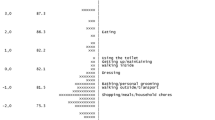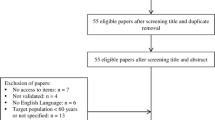Abstract
A new measure of Instrumental Activities of Daily Living (IADL), which is able to discriminate among the large group of elderly who do not depend on help, was tested for content validity and construct validity. Most assessments of functional ability include Physical ADL (PADL) and Instrumental ADL (IADL). PADL-scales assess the basic capacity of persons to care for themselves. lADL-scales are used to assess somewhat higher levels of performance, such as the ability to perform household chores or go shopping. Data were collected from 734 70-year-old people in Denmark in the county of Copenhagen. The measure of Instrumental ADL included 30 activities in relation to tiredness and reduced speed. Construct validity was tested by the Rasch model for item analysis; internal validity was specifically addressed by assessing the homogeneity of items under different conditions. The Rasch item analysis of IADL showed that 14 items could be combined into two qualitatively different additive scales. The IADL-measure complies with demands for content validity, distinguishes between what the elderly actually do, and what they are capable of doing, and is a good discriminator among the group of elderly persons who do not depend on help. It is also possible to add the items in a valid way. However, to obtain valid IADL-scales, we omitted items that were highly relevant to especially elderly women, such as house-work items. We conclude that the criteria employed for this IADL-measure are somewhat contradictory. (Aging Clin. Exp. Res. 5: 371-383, 1993)
Similar content being viewed by others
References
Fillenbaum G.G.: The well-being of the Elderly. Approaches to multidimensional assessment. World Health Organization, Geneva, 1984.
Kane R.A., Kane R.L.: Assessing the Elderly. A practical guide to measurement. Lexington Books, Toronto, 1981.
Feinstein A.R., Josephy B.R., Wells C.K.: Scientific and clinical problems in indexes of functional disability. Ann. Intern. Med. 105: 413–420, 1986.
Fillenbaum G.G.: Screening the elderly. A brief instrumental Activities of Daily Living measure. J. Am. Geriatr. Soc. 33: 698–706, 1985.
Spector W.D., Katz S., Murphy J.B., Fulton J.P.: The hierarchical relationship between Activities of Daily Living and Instrumental Activities of Daily Living. J. Chronic Dis. 40: 481–489, 1987.
Asberg K.H., Sonn U.: The cumulative structure of Personal and Instrumental ADL. A Study of Elderly People in a Health Service District. Scand. J. Rehabil. Med. 21: 171–177, 1988.
Koyano W., Shibata H., Hakazato K., Haga H., Suyama Y., Matsuzaki T.: Prevalence of disability in Instrumental Activities of Daily Living among elderly Japanese. J. Gerontol. 43: S41–S45, 1988.
Katz S., Ford A.B., Moskowitz R.W., Jackson B.A., Jaffe M.W.: Studies of illness in the aged. J.A.M.A. 12: 914–919, 1963.
Mahoney F.I., Barthel D.W.: Functional evaluation: The Barthel Index. M. State Med. J. 14: 61–65, 1965.
Ware J.E., Brook R.H., Davies A.R., Lohr K.N.: Choosing measures of health status for individuals in general populations. Am. J. Public Health 71: 620–625, 1981.
McDowell I., Newell C.: Measuring health: A guide to rating scales and questionnaires. Oxford University Press, Oxford, 1987.
Kirshner B., Guyatt G.: A methodological framework for assessing health indices. J. Chronic Dis. 38: 27–36, 1985.
Ware J.E. Jr.: Standards for validating health measures: Definition and content. J. Chronic Dis. 40: 473–480, 1987.
Guyatt G.H., Deyo R.A., Charlsen M., Levine M.N., Mitchell A.: Responsiveness and validity in health status measurement: A clarification. J. Clin. Epidemiol. 42: 403–408, 1989.
Lawton M.P., Moss M., Fulcomer M., Kleban M.H.: A research and service oriented multilevel assessment instrument. J. Gerontol. 37: 91–99, 1982.
Fillenbaum G.G., Smyer M.A.: The development, validity and reliability of the OARS Multidimensional Functional Questionnaire. J. Gerontol. 36: 428–434, 1981.
Hellevik O.: Forskningsmetode i sosiologi og statsvitenskap, ed. 3. Universitetsforlaget, Oslo, 1984, pp. 108–140.
Andrich D.: Rasch models for measurement. Sage University Paper. Series on Quantitative Applications in the Social Sciences. Series no. 07-001. Sage Publications, Beverly Hills and London, 1988.
Cronbach L.J.: Test validation. In: Thorndike R.L. (Ed.), Educational Measurement. American Council on Education, Washington D.C., 1971, pp. 443–507.
Foldspang A., Juul S., Olsen J., Sabroe S.: Epidemiologi. Sygdom og befolkning, ed. 2. Munksgård, Copenhagen, 1986.
Teresi J.A., Golden R.R., Gurland B.J., Wilder D.E., Bennet R.G.: Construct validity of indicator-scales developed from the Comprehensive Assessment and Referral Evaluation Interview Schedule. J. Gerontol. 39: 147–157, 1984.
Avlund K., Schultz-Larsen K.: What do 70-year-old men and women do? And what are they able to do? From the Glostrup Survey in 1984. Aging Clin. Exp. Res. 3: 39–49, 1991.
Fillenbaum G.G.: Assessment of health and functional status: An international comparison. In: Kane R.L., Evans J.G., MacFayden D. (Eds.), Improving the health of older people. Oxford University Press, Oxford, 1990, pp. 69–90.
Heikkinen E., Waters W.E., Brzezinski Z.J.: The elderly in eleven countries. A sociomedical survey. World Health Organization, Copenhagen, 1983.
Waters W.E., Heikkinen E., Dontas A.S.: Health, lifestyles and services for the elderly. Public Health in Europe. World Health Organization, Copenhagen, 1989.
Avlund K., Kreiner S., Schultz-Larsen K.: Construct validation and the Rasch model: Functional ability of healthy elderly people. Scand J. Soc. Med. (In press).
Schultz-Larsen K., Avlund K., Kreiner S.: Functional ability of community dwelling elderly. Criterion validity of a new measure of functional ability. J. Clin. Epidemiol 45: 1315–1326, 1992.
Hambleton R.K., Rogers H.J.: Solving criterion-referenced measurement problems with item response models. Int. J. Educ. Res. 13: 145–160, 1989.
Rosenbaum P.: Criterion-related construct validity. Psychometrika 54: 625–634, 1989.
Lord F.: Applications of item response theory to practical testing problems. Lawrence Erlbaum Associates, Inc., New Jersey, 1980.
Guttman L.: The basis of scalogram analysis. In: Stouffer S.A., Guttman L., Suchman E.A, Lazarsfield P.F., Star S.A., Clausen J.A. (Ed.), Measurement and prediction. Princeton University Press, New York, 1950, pp. 60–90.
Cook L.L., Eignor D.R.: Using item response theory in test-score equating. Int. J. Educ. Res. 13: 161–173, 1989.
Williams M.E., Hadler N.M., Earp J.A.L.: Manual ability as a marker of dependency in geriatric women. J. Chronic Dis. 35: 115–122, 1982.
Williams M.E., Hornberger J.C.: A quantitative method of identifying older persons at risk for increasing Long Term Care Services. J. Chronic Dis. 9/10: 705–711, 1984.
Lundgren-Lindquist B.: Functional capability in 79-year-old women and men. University of Gothenburg; The Department of Rehabilitation Medicine and Geriatric and Long-Term Care Medicine, Thesis, 1982.
Hunt S.M., McKenna S.P., McEwen J., Williams J., Papp E.: The Nottingham Health Profile: Subjective health status and medical consultations. Soc. Sci. Med. 15A: 221–229, 1981.
Dawson D., Hendershot G., Fulton J.: Aging in the eighties. Functional limitations of individuals age 65 years and over. National Center for Health Statistics. Advance Data from Vital and Health Statistics. No. 133. DHHS Pub. No. (PHS) 87-1250. Public Health Service. Hyattsville, MD, June 10. 1987, pp. 1–12.
Holstein B., Almind G., Due P., Holst E.: Ældres selvrapporterede helbred og lægemiddelforbrug. Ugeskr. Laeger 152: 286–391, 1990.
Rosow I., Breslau N.: A Guttman health scale for the aged. J. Gerontol 21: 556–559, 1966.
Lawton M.P., Brody E.M.: Assessment of older people: Self-maintaining and Instrumental Activities of Daily Living. Gerontologist 9: 179–186, 1969.
Bergström G., Aniansson A., Bjelle A., Grimby G., Lundgren-Lindquist B., Svanborg A.: Functional consequences of joint impairment at age 79. Scand. J. Rehabil. Med. 17: 183–190, 1985.
Hendriksen C., Lund E., Strømgård E.: Ældre menneskers funktionsformåen. En opgørelse fra “Rødovre-projektet”. Ugeskr. Laeger 149: 1835–1839, 1987.
Manton K.G.: The linkage of health status changes and disability. Comprehensive Gerontology A 1: 16–24, 1987.
Lammi U.K., Kivelä S.K., Nissinen A., Pekkanen J., Punsar S.: Functional capacity and associated factors in elderly Finnish men. Scand. J. Soc. Med. 17: 67–75, 1989.
Manton K.G.: A longitudinal study of functional change and mortality in the United States. J. Gerontol. 54: 625–634, 1988.
Jette A.M., Branch L.G.: The Framingham Disability Study: II. Physical disability among the aging. Am. J. Public Health 71: 1211–1216, 1981.
Gossman-Hedström G., Aniansson A., Persson G.B.: ADL-reduction and need for technical aids among 70-year-olds. Comprehensive Gerontology B 2: 16–23, 1988.
Jette A.M., Pinsky J.L., Branch L.G., Wolf P.A., Feinleib M.: The Framingham Disability Study: Physical disability among community-dwelling survivors of stroke. J. Clin. Epidemiol. 41: 719–726, 1988.
Manton K.G.: Epidemiological, demographic, and social correlates of disability among the elderly. Milbank Q. 67: 13–58, 1989.
Warren H.H.: Self-perception of independence among urban elderly. Am. J. Occ. Ther. 28: 329–336, 1974.
Wade D.T., Legh-Smith J., Hewer R.L.: Social activities after stroke: measurement and natural history using the Frenchay Activities Index. Int. Rehabil. Med. 7: 176–181, 1985.
Kivelä S.K.: Measuring disability — do self-ratings and service provider ratings compare? J. Chronic Dis. 37: 115–123, 1984.
Jette A.M., Deniston O.L.: Inter-observer reliability of a functional status assessment instrument. J. Chronic Dis. 31: 573–580, 1978.
Pollard W.E., Bobbitt R.A., Bergner M., Martin D.P., Gilson B.S.: The Sickness Impact Profile: Reliability of a health status measure. Med. Care 14: 146–155, 1976.
Sheikh K., Smith D.S., Meade T.W., Goldenberg E., Brennan P.J., Kinsella G.: Repeatability and validity of a modified Activities of Daily Living (ADL) index in studies of chronic disability. Int. Rehab. Med. 1: 51–58, 1979.
Haworth R.K., Hollings E.M.: Are hospital assessments of daily living activities valid? Int. Rehab. Med. 1: 59–62, 1979.
Parkerson G.R., Gehlbach S.H., Wagner E.H., James S.A., Clapp N.E., Muhlbaier L.H.: The Duke-UNC Health Profile: An adult health status instrument for primary care. Med. Care 19: 806–828, 1981.
Sonn U., Åsberg K.H.: Assessment of Activities of Daily Living in the elderly. A study of a population of 76-year-olds in Gothenburg, Sweden. Scand. J. Rehabil. Med. 23: 193–202, 1991.
Pfeffer R.I., Kurosaki T.T., Harrah C.H., Chance J.M., Filos S.: Measurement of functional activities in older adults in the community. J. Gerontol. 37: 323–329, 1982.
Teresi J.A., Cross P.S., Golden R.R.: Some applications of latent trait analysis to the measurement of ADL. J. Gerontol. 44: S196–S204, 1989.
Fugl-Meyer A.R., Jääskö L.: Post-stroke hemiplegia and ADL-performance. Scand. J. Rehabil. Med. (Suppl 7): 140-152, 1980.
Rubenstein L.Z., Schairer C., Wieland G.D., Kane R.: Systematic biases in functional status assessment of elderly adults: Effects of different data sources. J. Gerontol. 39: 686–691, 1984.
Magaziner J., Simonsick E.M., Kashner T.M., Hebel J.R.: Patient-proxy response comparability on measures of patient health and functional status. J. Clin. Epidemiol. 41: 1065–1074, 1988.
Lindmark B., Hamrin E.: Instrumental Activities of Daily Living in two patient populations, three months and.one year after stroke. Scand. J. Caring Sci. 3: 161–169, 1989.
Andersen E.B.: Discrete statistical models with social science applications. North-Holland Publishing Company, Amsterdam, New York, Oxford, 1980.
Gustafsson J-E.: Testing and obtaining fit of data to the Rasch Model. Er. J. Math. Stat. Psychol. 33: 205–233, 1980.
Kreiner S.: Analysis of multidimensional contingency tables by exact conditional tests: Techniques and strategies. Scandinavian Journal of Statistics 14: 97–112, 1987.
Kreiner S.: Rasch 1 & 2. Programs for item analysis. Technical Report. Danish Institute for Educational Research, Copenhagen, 1985.
Author information
Authors and Affiliations
Rights and permissions
About this article
Cite this article
Avlund, K., Schultz-Larsen, K. & Kreiner, S. The measurement of Instrumental ADL: Content validity and construct validity. Aging Clin Exp Res 5, 371–383 (1993). https://doi.org/10.1007/BF03324192
Received:
Accepted:
Published:
Issue Date:
DOI: https://doi.org/10.1007/BF03324192




